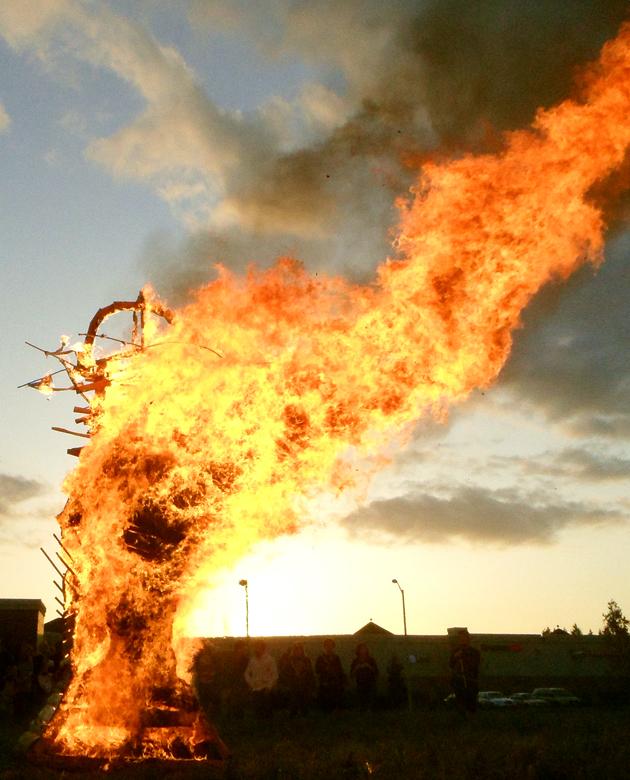
“People burn lots of things for lots of reasons,” Totem Shriver, adjunct professor of art and visual culture, said. “People come out of the woodworks to watch a fire; there’s just something mysterious and powerful [about it].”
And people certainly did show up from all corners of the Linfield and McMinnville communities to watch Built to Burn 2010 on April 22. The event highlighted the destruction of a wooden sculpture built by Shriver’s January Term Introduction to Studio Art class.
About 100 people attended last year’s event — the burning’s debut appearance — and this year’s event was no less successful.
Students, alumni and McMinnville residents crowded around the tall sculpture. Some carried long sticks in the hopes of roasting s’mores, and others ate food provided by a small potluck, which began at 7 p.m.
The audience also flocked around a notepad to write down thoughts, secrets and stresses to be burned with the sculpture.
Then, everyone backed away. 7:45. Flame on.
Shouts, cheers and clapping filled the air, almost drowned out by the popping of the fire, which one audience member said “sounded like a shotgun.”
Flames quickly engulfed the wooden figure. In fact, the sculpture’s top sumbled from its body within the first five minutes. And, after another five, the monstrous figure collapsed in on itself.
“I’m glad the whole thing didn’t tip over,” sophomore Sophie Corr, who was a member of Shriver’s class, said. “It’s sad now that it’s done… but burning it on Earth Day, I mean, what more can you ask [for]?”
Mac residents Nanette and Jeff Villarreal, friends of Shriver, said the fire was the main reason they attended. And their only critique: “Bigger next year.”
The process of approval and planning the event went smoothly this year. Rumors of a disgruntled farmer, supposedly left in the dark of last year’s burning on his rented land, were false, Shriver said.
Gordon Kroemer, director of the Office of Environment, Health & Safety, said that he sought permission for the event from the McMinnville Fire Department, Linfield College Community Public Safety & Security, Facility Services and the renter of the field; all gave the OK.
In fact, the burning is good for the earth because of the carbon released from the burning.
“Where the burn took place last year, the grass is actually thicker than the other areas around it,” Brian Winkenweder, chairman of the art and visual culture department and associate professor of art history, said.
The burning ritual is not just good for the ground. It’s also good for the soul.
“Burning is a spiritual activity: It’s taking something solid and turns it into gas, allowing it to escape, so it allows your troubles to escape,” Winkenweder said. “That’s a good lesson for students — that they can make something they really care about and let it go at the same time.”
Shriver agreed.
“There’s many people all around the world that burn things, and I think the common [reasons] are purification and transformation,” he said.
The colossal wooden sculpture was literally built to be burned. Shriver’s January Term class was broken in to groups to each create a part of the sculpture, made of scrap wood donated from a cedar mill.
Freshman Tessa Hanson helped build the piece’s spherical section. While building a round shape from straight wood was frustrating, Hanson said the most frustrating aspect was collaborative work.
“Most of the people in the class were artists and are used to doing independent work,” she said.
But, to Hanson, this collaboration was also the most valuable experience because the class inevitably became united by the process.
“Art is like a vehicle for community,” Shriver said. “I just think it’s important for the artist, especially the student artist, to get out of the building and create something on a scale that gets some feedback from others.”
Bringing together each group’s work in the end was also a challenge, Hanson said. But the final sculpture, called “The Ballad of Life: Beginning to End,” really came together in the end, she said.
“It’s reminiscent of the human form and maybe the feminine human form,” Shriver said.
Hanson said the figure’s title reflected the work that went into the piece and symbolized the class’s collective thanks to life. And burning it, although technically destructive, was actually an exciting prospect.
“What teacher tells you you’re just going to burn this in the end?” Hanson said. “I don’t think it put our work to waste.”
Kelley Hungerford
Managing editor Kelley Hungerford can be reached at [email protected]






